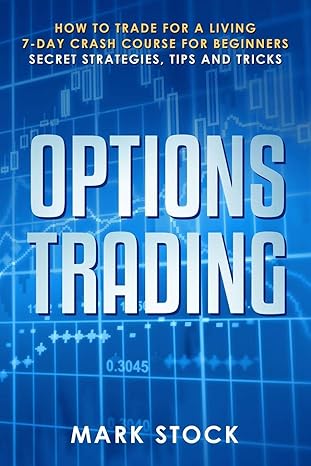Answered step by step
Verified Expert Solution
Question
1 Approved Answer
Just looking to have the cost of debt and after-tax cost of debt explained. Step 4: Calculate the Cost of Debt for the firm. Use
Just looking to have the cost of debt and after-tax cost of debt explained.

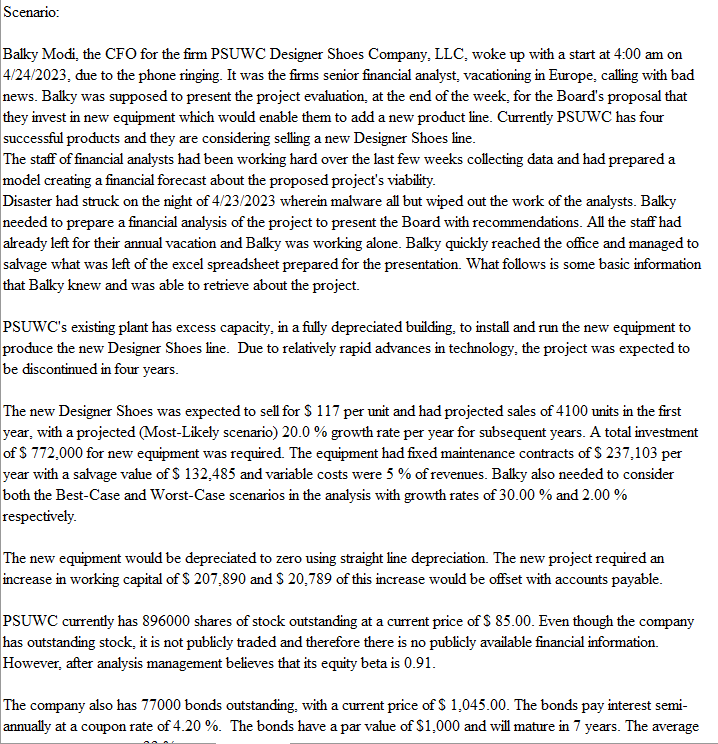
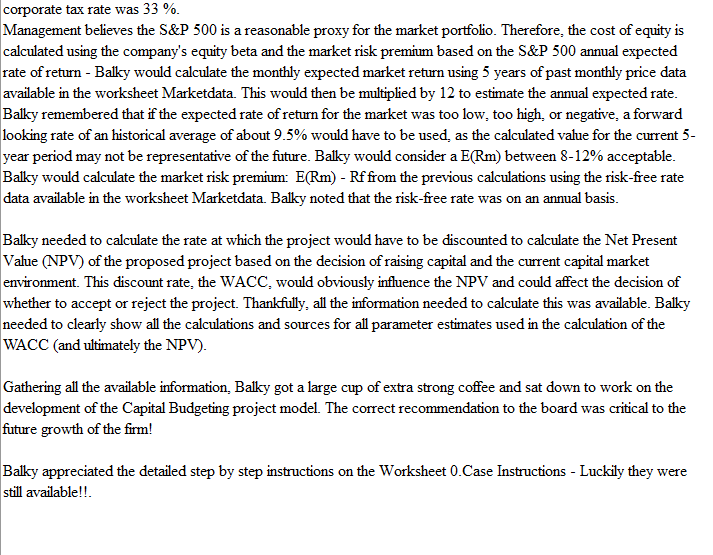

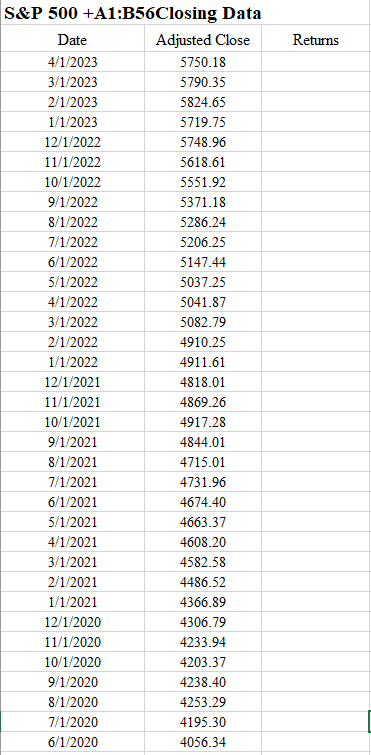
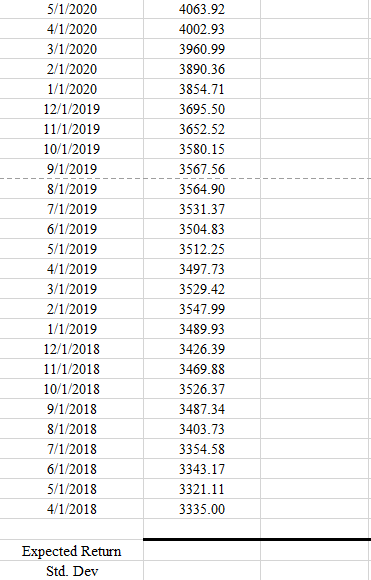

Step 4: Calculate the Cost of Debt for the firm. Use the information provided about the firms bonds to calculate the YTM. Step 5: Calculate the after-tax cost of debt. Use the given tax rate for the firm. Scenario: Balky Modi, the CFO for the firm PSUWC Designer Shoes Company, LLC, woke up with a start at 4:00 am on 4/24/2023, due to the phone ringing. It was the firms senior financial analyst, vacationing in Europe, calling with bad news. Balky was supposed to present the project evaluation, at the end of the week, for the Board's proposal that they invest in new equipment which would enable them to add a new product line. Currently PSUWC has four successful products and they are considering selling a new Designer Shoes line. The staff of financial analysts had been working hard over the last few weeks collecting data and had prepared a model creating a financial forecast about the proposed project's viability. Disaster had struck on the night of 4/23/2023 wherein malware all but wiped out the work of the analysts. Balky needed to prepare a financial analysis of the project to present the Board with recommendations. All the staff had already left for their annual vacation and Balky was working alone. Balky quickly reached the office and managed to salvage what was left of the excel spreadsheet prepared for the presentation. What follows is some basic information that Balky knew and was able to retrieve about the project. PSUWC's existing plant has excess capacity, in a fully depreciated building, to install and run the new equipment to produce the new Designer Shoes line. Due to relatively rapid advances in technology, the project was expected to be discontinued in four years. The new Designer Shoes was expected to sell for $117 per unit and had projected sales of 4100 units in the first year, with a projected (Most-Likely scenario) 20.0% growth rate per year for subsequent years. A total investment of $772,000 for new equipment was required. The equipment had fixed maintenance contracts of $237,103 per year with a salvage value of $132,485 and variable costs were 5% of revenues. Balky also needed to consider both the Best-Case and Worst-Case scenarios in the analysis with growth rates of 30.00% and 2.00% respectively. The new equipment would be depreciated to zero using straight line depreciation. The new project required an increase in working capital of $207,890 and $20,789 of this increase would be offset with accounts payable. PSUWC currently has 896000 shares of stock outstanding at a current price of $85.00. Even though the company has outstanding stock, it is not publicly traded and therefore there is no publicly available financial information. However, after analysis management believes that its equity beta is 0.91 . The company also has 77000 bonds outstanding, with a current price of $1,045.00. The bonds pay interest semiannually at a coupon rate of 4.20%. The bonds have a par value of $1,000 and will mature in 7 years. The average Management believes the S\&P 500 is a reasonable proxy for the market portfolio. Therefore, the cost of equity is calculated using the company's equity beta and the market risk premium based on the S\&P 500 annual expected rate of return - Balky would calculate the monthly expected market return using 5 years of past monthly price data available in the worksheet Marketdata. This would then be multiplied by 12 to estimate the annual expected rate. Balky remembered that if the expected rate of return for the market was too low, too high, or negative, a forward looking rate of an historical average of about 9.5% would have to be used, as the calculated value for the current 5 year period may not be representative of the future. Balky would consider a E(Rm) between 812% acceptable. Balky would calculate the market risk premium: E(Rm) - Rf from the previous calculations using the risk-free rate data available in the worksheet Marketdata. Balky noted that the risk-free rate was on an annual basis. Balky needed to calculate the rate at which the project would have to be discounted to calculate the Net Present Value (NPV) of the proposed project based on the decision of raising capital and the current capital market environment. This discount rate, the WACC, would obviously influence the NPV and could affect the decision of whether to accept or reject the project. Thankfully, all the information needed to calculate this was available. Balky needed to clearly show all the calculations and sources for all parameter estimates used in the calculation of the WACC (and ultimately the NPV). Gathering all the available information, Balky got a large cup of extra strong coffee and sat down to work on the development of the Capital Budgeting project model. The correct recommendation to the board was critical to the future growth of the firm! Balky appreciated the detailed step by step instructions on the Worksheet 0 .Case Instructions - Luckily they were still available!!. Company=RiskFreeRate(Rf)=0.911.90% S\&P 500+ A1:B56Closing Data \begin{tabular}{|c|c|c|} \hline Date & Adjusted Close & Returns \\ \hline 4/1/2023 & 5750.18 \\ \hline 3/1/2023 & 5790.35 \\ \hline 2/1/2023 & 5824.65 \\ \hline 1/1/2023 & 5719.75 \\ \hline 12/1/2022 & 5748.96 \\ \hline 11/1/2022 & 5618.61 \\ \hline 10/1/2022 & 5551.92 \\ \hline 9/1/2022 & 5371.18 \\ \hline 8/1/2022 & 5286.24 \\ \hline 7/1/2022 & 5206.25 \\ \hline 6/1/2022 & 5147.44 \\ \hline 5/1/2022 & 5037.25 \\ \hline 4/1/2022 & 5041.87 \\ \hline 3/1/2022 & 5082.79 \\ \hline 2/1/2022 & 4910.25 \\ \hline 1/1/2022 & 4911.61 \\ \hline 12/1/2021 & 4818.01 \\ \hline 11/1/2021 & 4869.26 \\ \hline 10/1/2021 & 4917.28 \\ \hline 9/1/2021 & \\ \hline 8/1/2021 & 4844.01 \\ \hline 7/1/2021 & 4715.01 \\ \hline 6/1/2021 & 4731.96 \\ \hline 5/1/2021 & 4674.40 \\ \hline 4/1/2021 & 4663.37 \\ \hline 3/1/2021 & 4608.20 \\ \hline 2/1/2021 & 4582.58 \\ \hline 1/1/2021 & 4486.52 \\ \hline 12/1/2020 & 4366.89 \\ \hline 11/1/2020 & 4306.79 \\ \hline 10/1/2020 & 4233.94 \\ \hline 9/1/2020 & 4203.37 \\ \hline 8/1/2020 & 4238.40 \\ \hline 7/1/2020 & 4253.29 \\ \hline 6/1/2020 & 4195.30 \\ \hline \end{tabular} \begin{tabular}{|c|c|c|} \hline 5/1/2020 & 4063.92 \\ \hline 4/1/2020 & 4002.93 \\ \hline 3/1/2020 & 3960.99 \\ \hline 2/1/2020 & 3890.36 \\ \hline 1/1/2020 & 3854.71 \\ \hline 12/1/2019 & 3695.50 \\ \hline 11/1/2019 & 3652.52 \\ \hline 10/1/2019 & 3580.15 \\ \hline 9/1/2019 & 3567.56 & \\ \hline 8/1/2019 & 3564.90 \\ \hline 7/1/2019 & 3531.37 \\ \hline 6/1/2019 & 3504.83 \\ \hline 5/1/2019 & 3512.25 & \\ \hline 4/1/2019 & 3497.73 \\ \hline 3/1/2019 & 3529.42 \\ \hline 2/1/2019 & 3547.99 \\ \hline 1/1/2019 & 3489.93 \\ \hline 12/1/2018 & 3426.39 \\ \hline 11/1/2018 & 3469.88 \\ \hline 10/1/2018 & 3526.37 \\ \hline 9/1/2018 & 3487.34 \\ \hline 8/1/2018 & 3403.73 \\ \hline 7/1/2018 & 3354.58 \\ \hline 6/1/2018 & 3343.17 \\ \hline 5/1/2018 & 3321.11 & \\ \hline 4/1/2018 & 3335.00 & \\ \hline & & \\ \hline \end{tabular} Expected Return Std. Dev Cost of Debt (rd) After-Tax Cost of Debt Step 4: Calculate the Cost of Debt for the firm. Use the information provided about the firms bonds to calculate the YTM. Step 5: Calculate the after-tax cost of debt. Use the given tax rate for the firm. Scenario: Balky Modi, the CFO for the firm PSUWC Designer Shoes Company, LLC, woke up with a start at 4:00 am on 4/24/2023, due to the phone ringing. It was the firms senior financial analyst, vacationing in Europe, calling with bad news. Balky was supposed to present the project evaluation, at the end of the week, for the Board's proposal that they invest in new equipment which would enable them to add a new product line. Currently PSUWC has four successful products and they are considering selling a new Designer Shoes line. The staff of financial analysts had been working hard over the last few weeks collecting data and had prepared a model creating a financial forecast about the proposed project's viability. Disaster had struck on the night of 4/23/2023 wherein malware all but wiped out the work of the analysts. Balky needed to prepare a financial analysis of the project to present the Board with recommendations. All the staff had already left for their annual vacation and Balky was working alone. Balky quickly reached the office and managed to salvage what was left of the excel spreadsheet prepared for the presentation. What follows is some basic information that Balky knew and was able to retrieve about the project. PSUWC's existing plant has excess capacity, in a fully depreciated building, to install and run the new equipment to produce the new Designer Shoes line. Due to relatively rapid advances in technology, the project was expected to be discontinued in four years. The new Designer Shoes was expected to sell for $117 per unit and had projected sales of 4100 units in the first year, with a projected (Most-Likely scenario) 20.0% growth rate per year for subsequent years. A total investment of $772,000 for new equipment was required. The equipment had fixed maintenance contracts of $237,103 per year with a salvage value of $132,485 and variable costs were 5% of revenues. Balky also needed to consider both the Best-Case and Worst-Case scenarios in the analysis with growth rates of 30.00% and 2.00% respectively. The new equipment would be depreciated to zero using straight line depreciation. The new project required an increase in working capital of $207,890 and $20,789 of this increase would be offset with accounts payable. PSUWC currently has 896000 shares of stock outstanding at a current price of $85.00. Even though the company has outstanding stock, it is not publicly traded and therefore there is no publicly available financial information. However, after analysis management believes that its equity beta is 0.91 . The company also has 77000 bonds outstanding, with a current price of $1,045.00. The bonds pay interest semiannually at a coupon rate of 4.20%. The bonds have a par value of $1,000 and will mature in 7 years. The average Management believes the S\&P 500 is a reasonable proxy for the market portfolio. Therefore, the cost of equity is calculated using the company's equity beta and the market risk premium based on the S\&P 500 annual expected rate of return - Balky would calculate the monthly expected market return using 5 years of past monthly price data available in the worksheet Marketdata. This would then be multiplied by 12 to estimate the annual expected rate. Balky remembered that if the expected rate of return for the market was too low, too high, or negative, a forward looking rate of an historical average of about 9.5% would have to be used, as the calculated value for the current 5 year period may not be representative of the future. Balky would consider a E(Rm) between 812% acceptable. Balky would calculate the market risk premium: E(Rm) - Rf from the previous calculations using the risk-free rate data available in the worksheet Marketdata. Balky noted that the risk-free rate was on an annual basis. Balky needed to calculate the rate at which the project would have to be discounted to calculate the Net Present Value (NPV) of the proposed project based on the decision of raising capital and the current capital market environment. This discount rate, the WACC, would obviously influence the NPV and could affect the decision of whether to accept or reject the project. Thankfully, all the information needed to calculate this was available. Balky needed to clearly show all the calculations and sources for all parameter estimates used in the calculation of the WACC (and ultimately the NPV). Gathering all the available information, Balky got a large cup of extra strong coffee and sat down to work on the development of the Capital Budgeting project model. The correct recommendation to the board was critical to the future growth of the firm! Balky appreciated the detailed step by step instructions on the Worksheet 0 .Case Instructions - Luckily they were still available!!. Company=RiskFreeRate(Rf)=0.911.90% S\&P 500+ A1:B56Closing Data \begin{tabular}{|c|c|c|} \hline Date & Adjusted Close & Returns \\ \hline 4/1/2023 & 5750.18 \\ \hline 3/1/2023 & 5790.35 \\ \hline 2/1/2023 & 5824.65 \\ \hline 1/1/2023 & 5719.75 \\ \hline 12/1/2022 & 5748.96 \\ \hline 11/1/2022 & 5618.61 \\ \hline 10/1/2022 & 5551.92 \\ \hline 9/1/2022 & 5371.18 \\ \hline 8/1/2022 & 5286.24 \\ \hline 7/1/2022 & 5206.25 \\ \hline 6/1/2022 & 5147.44 \\ \hline 5/1/2022 & 5037.25 \\ \hline 4/1/2022 & 5041.87 \\ \hline 3/1/2022 & 5082.79 \\ \hline 2/1/2022 & 4910.25 \\ \hline 1/1/2022 & 4911.61 \\ \hline 12/1/2021 & 4818.01 \\ \hline 11/1/2021 & 4869.26 \\ \hline 10/1/2021 & 4917.28 \\ \hline 9/1/2021 & \\ \hline 8/1/2021 & 4844.01 \\ \hline 7/1/2021 & 4715.01 \\ \hline 6/1/2021 & 4731.96 \\ \hline 5/1/2021 & 4674.40 \\ \hline 4/1/2021 & 4663.37 \\ \hline 3/1/2021 & 4608.20 \\ \hline 2/1/2021 & 4582.58 \\ \hline 1/1/2021 & 4486.52 \\ \hline 12/1/2020 & 4366.89 \\ \hline 11/1/2020 & 4306.79 \\ \hline 10/1/2020 & 4233.94 \\ \hline 9/1/2020 & 4203.37 \\ \hline 8/1/2020 & 4238.40 \\ \hline 7/1/2020 & 4253.29 \\ \hline 6/1/2020 & 4195.30 \\ \hline \end{tabular} \begin{tabular}{|c|c|c|} \hline 5/1/2020 & 4063.92 \\ \hline 4/1/2020 & 4002.93 \\ \hline 3/1/2020 & 3960.99 \\ \hline 2/1/2020 & 3890.36 \\ \hline 1/1/2020 & 3854.71 \\ \hline 12/1/2019 & 3695.50 \\ \hline 11/1/2019 & 3652.52 \\ \hline 10/1/2019 & 3580.15 \\ \hline 9/1/2019 & 3567.56 & \\ \hline 8/1/2019 & 3564.90 \\ \hline 7/1/2019 & 3531.37 \\ \hline 6/1/2019 & 3504.83 \\ \hline 5/1/2019 & 3512.25 & \\ \hline 4/1/2019 & 3497.73 \\ \hline 3/1/2019 & 3529.42 \\ \hline 2/1/2019 & 3547.99 \\ \hline 1/1/2019 & 3489.93 \\ \hline 12/1/2018 & 3426.39 \\ \hline 11/1/2018 & 3469.88 \\ \hline 10/1/2018 & 3526.37 \\ \hline 9/1/2018 & 3487.34 \\ \hline 8/1/2018 & 3403.73 \\ \hline 7/1/2018 & 3354.58 \\ \hline 6/1/2018 & 3343.17 \\ \hline 5/1/2018 & 3321.11 & \\ \hline 4/1/2018 & 3335.00 & \\ \hline & & \\ \hline \end{tabular} Expected Return Std. Dev Cost of Debt (rd) After-Tax Cost of Debt
Step by Step Solution
There are 3 Steps involved in it
Step: 1

Get Instant Access to Expert-Tailored Solutions
See step-by-step solutions with expert insights and AI powered tools for academic success
Step: 2

Step: 3

Ace Your Homework with AI
Get the answers you need in no time with our AI-driven, step-by-step assistance
Get Started


